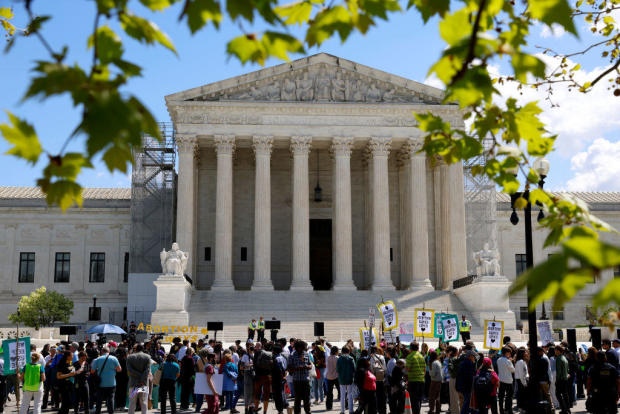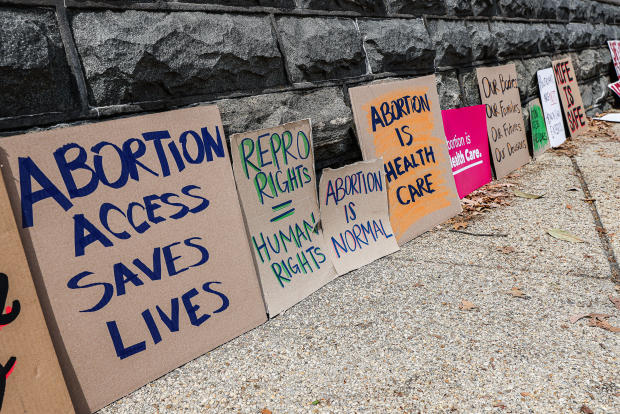▶ Watch Video: Supreme Court hears arguments on Idaho abortion ban
Washington — The Supreme Court on Wednesday appeared divided as it wrestled with a case pitting Idaho’s near-total ban on abortion against a federal law that requires hospitals to provide stabilizing care to patients experiencing medical emergencies.
The dispute between the Biden administration and Idaho officials in the case known as Moyle v. United States was the second involving abortion that the court has heard in the span of a month. But it marks the first time since the court’s decision overturning Roe v. Wade in June 2022 that the justices have considered a state law restricting access to the procedure.
The outcome of the case could determine whether the Biden administration can require hospitals in states with stringent abortion laws to offer pregnancy terminations in emergency situations.
The court fight involves the Emergency Medical Treatment and Labor Act, or EMTALA, which requires hospitals that participate in Medicare to stabilize patients facing an emergency medical condition.
The Biden administration has argued that in some cases, that treatment will be abortion care. In July 2022, after Roe’s reversal, it told hospitals accepting Medicare funds that physicians must offer abortions in certain medical emergencies. If a state law prohibits the procedure, or includes an exception that is more narrow than what EMTALA provides, it is overridden by the federal law, the Centers for Medicare and Medicaid Services said.
But Idaho officials, and opponents of abortion rights, argue EMTALA is silent on whether stabilizing care includes abortions, and it cannot displace a state’s own restrictions on the procedure.
Under Idaho’s law, which took effect after Roe’s reversal, abortions are only allowed when necessary “to prevent the death of the pregnant women,” or in cases of rape or incest. Physicians who perform abortions in violation of the measure may be charged with a felony and face up to five years in prison.
Oral arguments
During more than 90 minutes of arguments, the justices grappled with whether Idaho’s law allows for emergency abortion care in circumstances where it would be required under EMTALA. The four women on the Supreme Court dominated the first half of arguments, pressing Joshua Turner, who argued on behalf of the state, about the situations under which abortions could be provided by Idaho physicians.
Federal law “says that you don’t have to wait until the person is on the verge of death,” Justice Elena Kagan said. “If the woman is going to lose her reproductive organs, that’s enough to trigger this duty on the part of the hospital to stabilize the patient and the way to stabilize patients in these circumstances, all doctors agree.”
Justice Sonia Sotomayor noted that medical providers, lower courts and the Department of Health and Human Services have long said that abortion may be the stabilizing care required when a pregnant woman has an emergency medical condition.
“This is not a post-Dobbs, unprecedented position by the government,” she said.
Justices Brett Kavanaugh and Amy Coney Barrett focused on whether there is a conflict between Idaho’s law and EMTALA. Turner argued there is not, since an abortion would be allowed in certain emergency circumstances if the physician determined in “his good faith medical judgment” that it was necessary to save the life of the mother. Such a standard, he said, is “subjective.”
Barrett, though, pressed Turned on what would happen if another doctor disagreed.
“Would they be prosecuted under Idaho law?” Barrett asked. “What if the prosecutor thought differently? What if the prosecutor thought, well, I don’t think any good faith doctor could draw that conclusion?”
When asked to identify where EMTALA’s stabilization requirement did conflict with Idaho law, Turner raised mental health, suggesting that a pregnant woman could come in and say that a mental health issue demanded the termination of her pregnancy.
Echoing Turner’s assertion that the Biden administration’s position would allow emergency room doctors to perform abortions when necessary to avoid a risk to the mother’s mental health, Justice Samuel Alito asked Solicitor General Elizabeth Prelogar whether “health” under EMTALA included mental health.
But Prelogar, who represents the U.S. government before the Supreme Court, said that a pregnant woman suffering from a mental health emergency would never be treated with an abortion “because that is not the accepted standard of practice.” She would be stabilized and transferred under EMTALA, Prelogar said.
The fight over EMTALA
EMTALA was enacted in 1986 to address concerns that hospitals were engaging in “patient dumping” by discharging or transferring patients who did not have insurance. The law created a national minimum care standard for hospitals participating in Medicare by requiring them to offer stabilizing treatment to any patient with an emergency condition that threatens their life or health.
Soon after the Biden administration issued its guidance to hospitals regarding the stabilizing care that EMTALA requires, it sued Idaho, arguing its abortion ban is preempted by the federal law. A federal district court in Idaho sided with the federal government and allowed physicians to perform abortions in certain emergency situations.
A three-judge panel of the U.S. Court of Appeals for the 9th Circuit then allowed the law to be fully enforced while litigation continued. But the full 9th Circuit, which reviewed the panel’s ruling, reinstated the district court’s order in October.
The Supreme Court in early January said it would decide whether EMTALA overrides state laws that prohibit most abortions, but allowed Idaho to continue enforcing its ban in certain emergency medical situations until it issues a decision, expected by the end of June.
Prelogar told the justices during arguments that the Department of Health and Human Services, Congress and health care providers have long recognized that EMTALA requires hospitals to offer abortions when necessary to save the mother’s life or prevent serious harm to her health.
While stabilizing care sometimes involves terminating the pregnancy, instances where EMTALA and the Idaho abortion ban are at odds are rare, she wrote in a filing.
If a condition arises later in pregnancy and the fetus can be delivered, there is no conflict between the federal and state laws, she wrote. But it does arise when a pregnant woman is suffering from an emergency medical condition that, absent ending the pregnancy, threatens serious harm to her health, but not her life, Prelogar continued. In those circumstances, EMTALA overrides the Idaho ban, she said.
Prelogar told the justices that the instances where there is daylight between Idaho’s exception and what is required under federal law leads to “devastating consequences.”
“Idaho’s ban on abortion is enforceable in virtually all of its applications, but in the narrow circumstances involving grave medical emergencies, Idaho cannot criminalize the essential care that EMTALA requires,” she said.
Prelogar argued that delaying care until a pregnant woman’s condition deteriorates and the physician can say an abortion is necessary to save her life, as required under Idaho law, “stacks tragedy upon tragedy.”
But in filings with the court, lawyers for Idaho’s Republican legislative leader argued that EMTALA does not include a requirement for abortion care, and they accused the Biden administration of recasting the law as an abortion mandate.
“EMTALA is not [the Department of Health and Human Services’] Trojan horse for nationwide abortion rules. EMTALA nowhere mentions abortion,” Republican state lawmakers said in a brief. “Reading EMTALA as empowering HHS to displace state abortion laws defies the usual expectations of how Congress legislates and distorts the Constitution’s separation of powers.”
Turner told the Supreme Court that EMTALA’s stabilization requirement is limited to available treatments, and “illegal treatments are not available treatments.”
“If ER doctors can perform whatever treatment they determine is appropriate, than doctors can ignore not only state abortion laws, but also state regulations on opioid use and informed consent requirements. That turns the presumption against preemption on its head and leaves emergency rooms unregulated under state law,” he said.
During the arguments, Alito appeared the most skeptical of the Biden administration.
“How can you impose restrictions on what Idaho can criminalize simply because hospitals in Idaho have chosen to participate in Medicare?” he asked Prelogar.
Barrett called it “odd” that through a “side agreement between a private entity and the federal government, the private entity could get out of state law.” She asked whether in another presidential administration, Congress could stop hospitals that receive federal funds from performing abortions despite state constitutional amendments.
Alito also raised the inclusion of the phrase “unborn child” in the text of EMTALA, and questioned why it would be in a statute that requires abortions to be performed in certain medical emergency situations.
“Have you seen abortion statutes that use the phrase unborn child? Doesn’t that tell us something?” he said.
Alito said that what the Biden administration is asking the Supreme Court to do is to “construe this statute that was enacted back during the Reagan administration and signed by President Reagan to mean that there’s an obligation under certain circumstances to perform an abortion even if doing that is a violation of state law.”
The landscape after Roe’s reversal
Idaho is one of 14 states that outlaw abortion with some exceptions, according to the Guttmacher Institute, a pro-abortion rights research organization, while another seven outlaw abortion in the first 18 weeks of pregnancy.
Twenty-two states, many of which have the most stringent abortion laws, are siding with Idaho in the dispute, arguing that the Biden administration is attempting to invalidate state laws that protect the unborn.
No physician has been prosecuted or charged in Idaho for violating its ban. But the battle before the Supreme Court demonstrates the fallout from its decision unwinding the constitutional right to abortion and the challenges for physicians who are navigating states’ narrow exceptions to their abortion bans.
Dr. Jim Souza, chief physician executive for Boise-based St. Luke’s Health System, said there is now “second-guessing” and “hand-wringing” about whether an abortion can be performed within the bounds of Idaho’s law.
In 2023, when Idaho physicians could provide abortions in certain emergency situations under the district court’s order, one patient was transferred out of state, Souza said. But in the months since the Supreme Court has allowed Idaho to enforce its law in all circumstances, six patients with medical emergencies have been flown out of state, Souza said. He estimated that number will rise to 20 by the end of 2024.
While supporters of abortion rights are sounding the alarm about the consequences of a decision in favor of Idaho, the case has not received as much attention as a second abortion-related challenge heard by the Supreme Court last month, which involves the widely used abortion pill mifepristone.
In that case, a group of anti-abortion rights doctors and medical associations argued the Food and Drug Administration undertook a series of unlawful actions that made the drug more easier to obtain.
The Supreme Court appears poised to reject the challenge on procedural grounds. But that court fight and the dispute involving Idaho’s abortion ban and EMTALA underscore the chaotic landscape for abortion access in the wake of Roe’s reversal. Decisions from the high court in both of those cases are expected by the end of June.





































